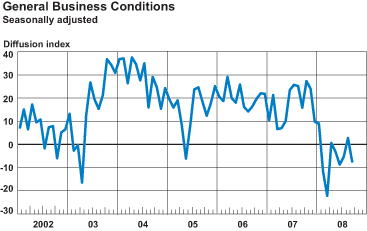Survey Indicators
Seasonally Adjusted

The Empire State Manufacturing Survey indicates that manufacturing activity in New York State weakened in September. The general business conditions index slipped 10 points, to -7.4. The new orders and shipments indexes rose modestly and were slightly above zero. Current employment indexes were negative. Current and future price indexes, though still elevated, retreated noticeably—particularly for prices paid. Indexes for future business conditions and most future activity measures remained close to last month’s levels or rose moderately in September.
In a series of supplementary questions (see Supplemental Report tab), manufacturers were asked to quantify past and expected changes in their firms’ selling prices; they were also asked to assess the probability that their prices would rise or fall by specified amounts. Respondents reported that their selling prices rose by an average of 4.8 percent over the past year; the median response was 4.0 percent. The average price increase expected over the next year was 3.6 percent, and the median was 3.3 percent. All of these increases were moderately larger than those reported in last September’s survey.
Business Conditions Weaken
The general business conditions index fell 10.2 points in September to -7.4, reversing most of the gains in the preceding two months and suggesting some renewed weakening in business conditions. Roughly 30 percent of respondents said that conditions had worsened in September, while 22 percent said that conditions had improved. After slipping below zero in August, the new orders measure rose 6.6 points, to 4.4. The shipments index edged up 1½ points, to 0.6. The unfilled orders index climbed roughly 5.5 points to -3.5, while the delivery time index slipped by slightly more than a point to
-4.6. The measure for inventories dropped nearly 8 points, to
-2.3, after briefly rising above zero in August.
Price Indexes Retreat
The prices paid index fell sharply for the second consecutive month after reaching a record high in July; this measure tumbled more than 20 points to 44.8—its lowest level since January. A little more than half of all respondents, down from more than two-thirds of those surveyed last month, reported paying higher prices. The prices received index fell slightly more than 8 points to 24.1, with 31 percent of respondents saying they had raised prices in September. Employment indexes were negative; the index for number of employees was virtually unchanged at -4.6, and the average workweek index slipped nearly 7 points to -5.8.
Six-Month Outlook Improves Somewhat
In September, the future general business conditions index climbed another 8½ points, to 43.1. Sixty percent of respondents expected conditions to improve over the next six months, while 17 percent expected them to worsen. The future new orders index edged down, while the future shipments indexes moved up; both measures were well above 40. Future price indexes declined noticeably: the index for expected prices paid tumbled 21 points to 48.3, while the measure for expected prices received fell roughly 10 points to 42.5. Future employment indexes were little changed at moderately positive levels. The future capital expenditures index inched up to 16.1, while the technology spending index rose more than 9 points, to 14.9—its highest level in several months.










